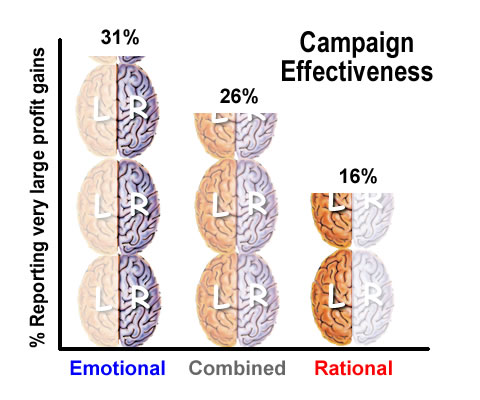
I’ve run across some pretty shrewd business owners, managers, and executives that balk at the idea of using hero-villain brand stories to drive conversions.
You know the “no-nonsense” types that just don’t get why simply focusing on their products doesn’t sell as well as stories.
So, they don’t buy it. It doesn’t make sense to them. (It’s why I wrote Mean People Suck btw)
“After all, my prospects know they have a problem,” they say. “And if I have a product that solves that problem, so I focus on communicating its features!”
Actually, many businesses and consumers don’t know they have a problem. Or, even more likely, they know that something isn’t right, but they don’t know exactly what it is.
Or, they have colleagues who don’t understand the problem and why it should be solved.
Which means that they won’t know that your product is the solution to what ails them.
Hero-villain brand stories drive conversions because they identify the problem (the “villain”) and show the prospect (the “hero”) how your product can help them overcome that particular challenge.
And they entertain, too. Although some of the no-nonsense execs might not see the need in going beyond “just the facts,” they’d be wrong about that, too.

When you engage the emotional side of your audience, it drives profits. Statistics don’t lie. And if you – or more likely, your boss – are concerned with “just the facts,” that’s one fact that you can’t deny.
And, there’s nothing like a hero-villain story to gin up strong feelings. So, let’s explore how to make your hero-villain brand stories drive conversions to the moon and back.
Quick Takeaways:
- Start with a compelling scene to set the stage.
- Make sure your story has a villain – the problems your prospects face.
- Make the prospect your story’s hero.
- Position your brand as the story’s wise guide – think Yoda.
- Let your products and services serve as the arsenal your prospects will use to conquer the villain.
Take a Tip from Hollywood: Grab Your Audience’s Attention at the Outset
Great TV shows and movies have one thing in common. They always start with a scene so memorable that it hooks the audience from the opening on.
Start with a Killer Scene
That scene usually features the show’s hero. And then, enter the villain – stage left.
Tension ensues. Game on.
Similarly, content marketers need to take a tip from these professional storytellers. Grabbing your audience’s attention from the first sentence is a must.
Promoting your brand and your products? Not so much.
When you lead with the challenge and tie it into what your target segment faces, they immediately identify with the story. And, they’ll stick around to see how it ends. After all, when it’s their story, they’re invested in finding a good ending.
Your products? They’ll come later. Much later.
Entice Them to Share with a Trailer
Ever been browsing through Netflix and saw a movie you weren’t interested in yourself, but that would be the perfect fit for your friend? So, you dash off a quick text to her with a link to the YouTube trailer of the movie.
In content marketing, your intro, plus a quick summary of the whole article afterward, serve as your “trailer.” These two items give your readers a chance to see if it deals with a challenge they face.
But, including a brief summary also allows readers who don’t face the same challenge to quickly identify if it would help a friend or colleague overcome their challenge. If you include a “click to tweet” or share button nearby, it will make it easy for a reader to pass your post on to someone who does need it.
As we all know, shares are a fantastic way to reach new audiences, new markets. When a regular reader shares your article, you’ll keep them – and possibly gain another audience member.
A Nielsen study shows that people trust content shared by friends, colleagues, and family much more than that shared on official brand channels. In fact, the same study shows that trust in content that your audience shares with their circle of influence outweighs even their trust in respected news articles.
That’s some kind of clout. If your intros and summary hit the mark, it can make a massive difference in your engagement, and ultimately, your bottom line.
Give Your Villain an Extra Dose of Nasty

Have you ever thought about how Star Wars would have turned out had Darth Vader never entered the picture? Luke Skywalker would probably have bumbled through life, never knowing what he could have accomplished.
So it is with your target audience. If they don’t know exactly what it is they’re facing and how it can hurt their company or their family, they won’t be able to get to the next level of their journey.
Dig into some research and uncover everything that the challenge your audience faces could unleash unless they tackle it head-on.
- The cracks in their home’s foundation from uncleaned gutters
- The business they’ll lose from not updating their SEO practices
- Their likelihood of catching a communicable disease without using hand sanitizer
Whatever problem your products and services solve, that’s your villain. Be sure to draw on the verbal horns and pitchfork that will alert your audience that there’s danger ahead.
Every Story Needs a Hero – Who’s Yours?
All too often, here’s where content marketers lose track of the storyline and veer off into blatant self-promotion. Instead of pinning a hero’s medal on their prospect, they feature their product as the hero of their brand story.
Although we call “hero’s journey” stories “brand stories,” that’s kind of a misnomer. They really should focus on customers, not your brand, showing how your solution can transform their businesses and lives for the better.
Your customers are the Luke Skywalkers, the Avatars, the Harry Potters of your content marketing universe. Putting your audience in the hero’s shoes creates a powerful emotional investment that will drive them to read through your hero’s journey to the very end.
So, What Role Does My Company Play in This Hero’s Journey?
Every hero’s journey has a wise leader. From Captain Kirk to Yoda, there’s always someone whose gift is to empower the hero.
That’s your brand – the guide who empowers your audience to climb mountains and conquer the villain.
Use the power of empathy to step into their shoes and identify how their current challenge drags them down. Then channel the content marketing Force and provide the kind of information and support that allows them to solve their problems.
To identify the problems your target audience faces, you need to look at the data. Your content and social media analytics can provide insights into their hopes, dreams, and pain points.
And, to discover other touchpoints that allow you to create stories that appeal to their specific interests, you can use demographic data, as well as social media likes, to narrow down your approach. When you take the time to do an in-depth look at the data, you’ll be able to create a more personalized approach for each audience segment.
Where Do My Products Factor into the Hero’s Journey?
Your products are the weapons your audience wields to fend off the story’s villain – the problem that holds them back from success. Think of them as virtual lightsabers.
They might be a software solution that helps streamline a company’s workflow. They might be an innovative new saw that makes it easier for builders to get buildings up faster. Or, they might be a diaper as secure as a mother’s hug.
Whatever your products and services are, you (or your founders) created them to solve a problem your customers face. Using a hero-villain story to frame them as the valuable tools they are puts your audience in the driver’s seat, leading the charge to put that villain in his place.
Time to Step Up and Become Your Brand Story’s Hero
Now, for your own hero’s journey. You and your employees are busy doing what you do best.
You don’t have time to produce the volume of content you need to reach all your potential customers. That’s where we enter the picture.
With quality content published consistently, you can bring more traffic to your site – and more revenue into your coffers. With our Content Builder Service, you can be your company’s hero.
Set up a quick consultation, and I’ll send you a free PDF version of my books. Get started today – and generate more traffic and leads for your business.
The post How to Make Hero-Villain Brand Stories Drive Conversions appeared first on Marketing Insider Group.
How to Make Hero-Villain Brand Stories Drive Conversions posted first on http://rssmix.com/u/11592782/rss.xml
No comments:
Post a Comment